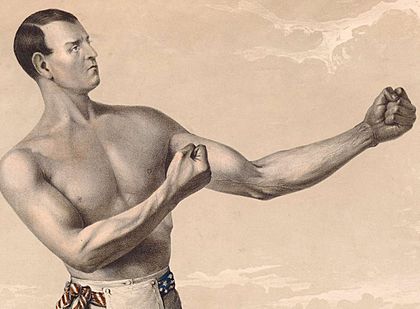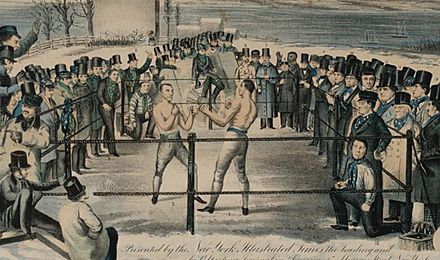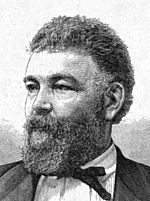Yankee Sullivan facts for kids
Quick facts for kids Yankee Sullivan |
|
|---|---|
 |
|
| Statistics | |
| Real name | James Ambrose |
| Nickname(s) | Frank Murray James Sullivan |
| Rated at | 160 lb (73 kg), middleweight |
| Height | 5 ft 10 in (1.78 m) Varies downward slightly in records |
| Nationality | Irish Settled in America by late 1841 Never returned to England |
| Born | 10 March 1811 Bandon, County Cork, Ireland |
| Died | 31 May 1856 (aged 45) San Francisco, California |
| Stance | Orthodox Long reach, right handed Used London Prize Ring Rules |
| Boxing record | |
| Total fights | 14 * professional bouts only |
| Wins | 12 |
| Losses | 2 |
Yankee Sullivan (born James Ambrose; c. 10 March 1811 – 31 May 1856) was a famous bare-knuckle fighter and boxer. He was also known by the names Frank Murray and James Sullivan. He claimed to be the American bare-knuckle heavyweight champion from 1851 to 1853. He said he became champion after Tom Hyer gave up his title. However, some boxing experts today do not agree with his claim. Yankee Sullivan lost his claim to the title after a fight with John Morrissey.
Contents
Early Life and Boxing Beginnings
James Ambrose was born in Bandon, County Cork, Ireland, in 1811. He grew up in London's East End and started prizefighting when he was young. For a time, he was sent to Australia. After some years, he was allowed to live freely and settled in Sydney.
On 2 February 1841, Sullivan won against Hammer Lane. This fight was for the Middleweight Championship of England. It lasted 19 rounds and took 34 minutes. When Sullivan first came to America, he fought Vincent Hammond on 2 September 1841. He won this fight in just eight short rounds, which took only ten minutes. Many Irish communities in America started to notice this new fighter.
After arriving in America in late 1841, Sullivan became known as a prizefighter. He also worked with Irish groups linked to Tammany Hall, a political organization. He owned a saloon called the Sawdust House in New York City.
Sullivan defeated Robert Caunt in a well-known fight. It took place in Harper's Ferry, West Virginia, and lasted eight rounds and twelve minutes. The agreement for a big fight between Sullivan and Tom Hyer was signed on 7 August 1848. This fight happened six months later.
Big Fight Against Tom Hyer in 1849
Rival Groups Behind the Fight
Sullivan met Tom Hyer in New York City in early 1849. Hyer was from New York and had Dutch family roots. Sullivan had planned to meet Hyer for a fight, possibly to get attention, but also to hurt him. Reports said Hyer won this short meeting. He then got a pistol to protect himself from Sullivan's friends who were arriving. The police came quickly and stopped any more trouble.
Sullivan had helped another fighter, Country McClosky, who had recently lost to Hyer. Sullivan wanted to get revenge for McClosky by beating Hyer. This fight between Sullivan and Hyer was more than just a boxing match. It showed the rivalry between two groups in New York. Hyer and his Bowery Boys gang represented people who were against immigrants. Sullivan and his followers represented Irish immigrants who were supported by Tammany Hall.
Boxing was often connected to politics in America during this time. Fighters sometimes worked with political groups that used force to help their candidates win elections. Different political groups often had gangs and fought in the streets.
Maryland Tries to Stop the Fight
Boxing was against the law in Maryland. To stop Sullivan and Hyer from fighting, Maryland's Attorney General, George Richardson, sent soldiers. They went to Pooles Island, where the fight was supposed to happen. But the boxers moved the fight to Still Pond heights, further east.
About 300 people had planned to watch the fight. But only about 200 spectators actually came. Some might have been afraid of being arrested by the Maryland soldiers.
Tom Hyer was almost four inches taller than Sullivan. He also weighed about 30 pounds more. This difference in size would likely prevent them from fighting today. Hyer's longer arms also gave him a big advantage. On 7 February 1849, Hyer finally defeated Sullivan. The fight started around 4:00 pm. It went 16 rounds at Still Pond Creek, an outdoor area in Maryland. It was a cold and snowy day.
Even though Sullivan was smaller, he had not lost any of his eight previous fights. These fights were mostly in Australia and England. He had even claimed the Middleweight championship of England.
Details of the Fight with Hyer
Sullivan hoped to use his grappling skills to wear down the bigger Hyer. In London Prize Ring Rules, it was allowed to throw your opponent. But this plan did not work. Hyer's greater reach and height helped him control the fight. Some reports say Sullivan did try to throw Hyer early in the match and had some success. He was even given credit for the first three throws.
As the fight went on, Sullivan fell down in the fourth round and again in the sixth, but he got back up. Within 17 minutes, Sullivan was badly hurt. His right eye was cut to stop it from swelling shut. By the thirteenth round, Sullivan was very tired. He was taking almost two punches for every weak one he threw at Hyer. Sullivan's right arm was twisted in the 15th round.
According to one newspaper, once Sullivan was exhausted, Hyer held his head under his arm in the 15th round. He then punched him many times. This attack ended the fight, and Sullivan could not come back for the 16th round. When Hyer stood up, it was clear Sullivan could not continue. Sullivan was unable to get up and had to be carried away by his helpers.
After winning, Hyer followed a tradition of London Prize Ring Rules. He tore Sullivan's green and white silk banner, which showed the colors of Ireland, from its pole. He then proudly showed it to the crowd. Hyer's banner had the American stars and stripes. This showed his connection to the Whig Party, which was linked to the Know Nothing Party.
After the fight, Sullivan was taken to Mt. Hope Hospital. He was treated for his injured arm, very bruised eyes, and a small skull fracture. He was released the next day. The fight lasted 17 minutes and 18 seconds. Hyer won a very large prize of $10,000. This was a very public boxing match at the time. It helped make the sport more popular, even though the fight was illegal in Maryland and very brutal.
Claiming the Heavyweight Title in 1851
After his fight with Sullivan, Hyer stopped boxing for a while. He went to run his bar in New York and recover from his injuries. Sullivan then claimed to be the champion in 1851. However, not all boxing experts today agree that he was the heavyweight champion.
Losing the Title in 1853
For a prize of $2000, Sullivan fought John Morrissey on 12 October 1853. About 4,500 people watched the fight. It took place at Boston Corner. This area was in Massachusetts but was hard for authorities to reach, making it a good spot for illegal matches.
Sullivan was the stronger fighter for the first 15 rounds. But he grew tired as the fight went on. Both fighters had taken many punches by the 37th round. Sullivan often fell down on purpose to end rounds, which was allowed by London Prize Ring Rules. In the earlier rounds, Morrissey took more hits, especially to his left eye, which was almost closed by the seventh round.
In the 37th round, Morrissey lifted Sullivan with his arm around his neck, holding him against the ropes. At this point, people watching rushed into the ring to protest. Once the crowd entered the ring, the fight turned into a brawl involving Sullivan and the helpers of both fighters. The referee later said Morrissey was the winner. This was partly because Morrissey did not join the brawl at the end of the 37th round. However, many people disagreed with the referee's decision. They believed Sullivan had clearly been winning the fight. Morrissey's injuries seemed so bad that some newspapers mistakenly reported he had died, but he fully recovered.
Life in California and Death
Sullivan later moved to California. He worked guarding ballot boxes to stop people from voting for candidates his employer did not support. He was guarding a ballot box that was changed, which led to James P. Casey winning a city office even though his name was not on the ballot.
Sullivan was arrested on 25 May 1856. He passed away on 31 May 1856. He was buried at Mission Dolores Cemetery in San Francisco. He had a wife and child in California, and another wife in New York. Two years later, a grave marker was put up for him. The headstone has a special message on it.
Images for kids






